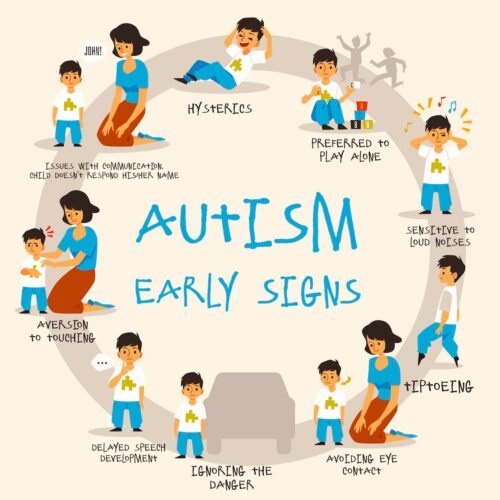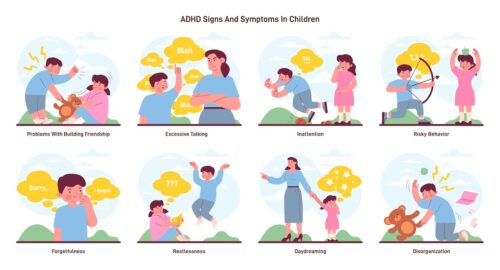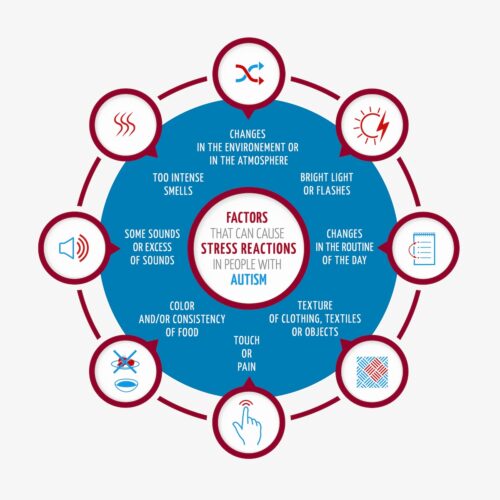Autism, attention deficit disorder (ADD), and attention deficit hyperactivity disorder (ADHD) are some of the most common neurodevelopmental disorders of childhood. Currently, these are so prevalent that they can be considered to be of epidemic proportions. Despite their pervasiveness, most experts can’t agree on the specific cause of these disorders but they concur that there is no cure. This article delves into neurodevelopmental disorders, specifically the prevalence and causes of autism, ADD, and ADHD, as well as treatments, and side effects.
What is Autism, ADD, and ADHD?
Before looking into the prevalence and causes of autism, ADD, and ADHD, as well as treatments, and side effects, let’s learn what specific symptoms are associated with these neurodevelopmental disorders. Autism, Attention Deficit Disorder (ADD), and Attention Deficit Hyperactivity Disorder (ADHD) can manifest with various symptoms. It’s interesting to note that boys are 4 times more likely than girls to be diagnosed with these conditions. Even though these children can present different symptoms, they have some common issues associated with each disorder:
Autism Spectrum Disorder (ASD):
- Social Difficulties: Autistic children have trouble understanding social cues, making and maintaining friendships, and difficulty understanding other people’s perspectives.
- Communication Challenges: They present delayed speech development, repetitive or unusual speech patterns, difficulty in initiating or sustaining conversations, and in understanding non-verbal communication such as gestures or facial expressions.
- Repetitive Behaviors: Some children engage in repetitive movements or actions (e.g., hand flapping, rocking), insist on sameness or routines, and present an intense interest in specific topics or objects.
- Sensory Sensitivities: Sometimes, they have a heightened or reduced sensitivity to sensory stimuli such as lights, sounds, textures, or smells.
- Difficulty with Change: Autistic children present resistance to changes in routines or environments, and difficulty transitioning from one activity to another.

Attention Deficit Disorder (ADD) and Attention Deficit Hyperactivity Disorder (ADHD):
- Inattention: Children with ADD and ADHD make careless mistakes, often appear forgetful, and have difficulty organizing and sustaining attention in tasks or activities.
- Hyperactivity (ADHD): They are restless, talk excessively, and have difficulty staying seated for long periods and engaging in leisure activities quietly.
- Impulsivity: Children with ADD and ADHD are impulsive, act without thinking or without considering the consequences, interrupt others, and have difficulty waiting for their turn.

Children with autism, ADD, and ADHD can share some common irregularities. They present brain inflammation, neuronal degeneration, gastrointestinal (GI) dysfunction, allergies, increased oxidative stress and serotonin levels, and altered immune responses.
Causes of Neurodevelopmental Disorders
Now that we understand the behaviors and traits associated with these neurodevelopmental disorders, let’s explore their accepted causes. Autism, ADHD, and ADD have an “unclear pathogenesis” and are not fully understood by the CDC or researchers. Yet, they believe these neurodevelopmental disorders result from a combination of genetic, environmental, and neurological factors:
- Genetic Factors: It’s believed that genetics plays a significant role in the development of autism, ADHD, and ADD and that a combination of multiple genetic variations may increase susceptibility.
- Environmental Factors: Exposure during pregnancy or early childhood to certain environmental factors is another contributing factor, such as maternal exposure to certain toxins, infections during pregnancy, or complications during birth. However, they can’t pinpoint specific environmental triggers.
- Brain Chemistry and Structure: They also believe that there are differences in the structure and function of certain brain regions, as well as imbalances in neurotransmitters (such as dopamine and norepinephrine), in individuals with neurodevelopmental disorders.
However, there are other contributing factors involved. The Children’s Health Defense has shown data linking these neurodevelopmental disorders to the following:
- Mitochondrial dysfunction
- Glyphosate (the active ingredient in Roundup)
- Exposure to PVC (a source of airborne phthalates indoors)
- Higher vaccination rates: Besides the data showing the correlation between the increased number of vaccines and rates of neurodevelopmental disorders, many parents with autistic children blame vaccines for their child’s autism, pinpointing their children’s behavior change after a pediatrician’s visit that involved vaccination.
The Prevalence of Neurodevelopmental Disorders
Besides learning about the causes of these neurodevelopmental disorders, it’s essential to pay attention to the prevalence of autism, ADD, and ADHD over the years to analyze treatments later on. The pervasiveness of neurodevelopmental disorders keeps expanding in exponential ways. Interestingly enough, rate increases match, in a linear pattern, increments in the vaccine schedule.
Let’s examine autism for instance:
- 1950s: Children received 5 vaccines [smallpox, polio, diphtheria, tetanus, pertussis] by age two, getting only one shot per visit. Back then, the cases of autism were rare.
- 1970s: Rates of autism were less than 3 per 10,000 children.
- 1980s: The vaccination schedule grew. Children received 24 doses by age 18 for seven illnesses and two combination vaccines [polio, DTaP (diphtheria, tetanus, pertussis), MMR (measles, mumps, rubella)].
- 1990s: Rates of autism were about 30 per 10,000 children.
- 1990 – Now: Most states mandate 72 doses for 17 vaccines that children have to take by age 18. By age 2, many children have taken 27 shots and up to six shots in a single visit [Measles, Mumps, Rubella, Chickenpox, Meningococcal Conjugate, DTaP (Diphtheria, Tetanus, Pertussis), Haemophilus Influenzae Type B (Hib), Rotavirus, HPV, Shingles, Pneumococcal Conjugate, hepatitis A, hepatitis B].
- 2000: Rates of autism skyrocketed to 1 in 150 children.
- 2010: 1 in 68 children was diagnosed with autism.
- Currently: 1 in 36 children is being diagnosed with autism and 1 in 6 (17%) children aged 3–17 years are being diagnosed with a developmental disability (autism, ADD, ADHD).
Despite this obvious correlation, the CDC still claims that vaccines are “safe and effective” and that “Vaccines Do Not Cause Autism.” Observing the deterioration of our children’s health over the years and the lack of interest by the CDC to address this horrific pattern, the Informed Consent Action Network sued the CDC in federal court asking for evidence that can back up their claims.
The CDC was ordered by a federal judge to show the evidence that substantiates the claim that vaccines don’t cause autism. After months of delays, eventually, the CDC provided 16 studies and 4 reviews. However, not one of them supported the claim that vaccines injected into babies – DTaP, Hep B, Hib, PCV13, and IPV – do not cause autism. Subsequently, the CDC entered into a stipulation that made clear the CDC “cannot scientifically support its claim that these vaccines do not cause autism.”
Treatment of Neurodevelopmental Disorders
Now that you know the prevalence and causes associated with autism, ADD, and ADHD, let’s explore the common treatments and side effects related to medications prescribed for these neurodevelopmental disorders. Full remission of symptoms in children diagnosed with a neurodevelopmental disorder is not that common. Yet, early intervention during the preschool years is critical since it can help them learn critical functional, behavioral, social, and communication skills, significantly improving outcomes for these children.
Additionally, treatment should be individualized based on the specific needs and strengths of children with neurodevelopmental disorders. Ongoing monitoring and assessments are also helpful since children are developing. It’s also important to have a collaborative care approach. A multidisciplinary team effort of pediatricians, psychologists, psychiatrists, therapists, educators, and other professionals can provide more comprehensive assessments and a more complete treatment plan.
Treatment varies greatly depending on the specific disorder, the physician involved, and the individual needs of the child but the following are the most common treatments available for children with neurodevelopmental disorders:
Behavioral Therapy
Behavioral therapy techniques such as Applied Behavior Analysis (ABA) and Cognitive Behavioral Therapy (CBT) are commonly used. ABA can help children learn new skills and generalize these skills to multiple situations through a reward-based motivation system. CBT can teach adaptive behaviors, social skills, and coping mechanisms by addressing the thoughts that are causing a cascade of negative emotions and subsequent challenging behaviors – Yet, CBT may be better suited for higher-functioning children.
Educational Interventions
Special education services, including Individualized Education Programs (IEPs) and specialized educational settings such as inclusion classrooms or special education schools, can provide tailored instruction and support to help children with neurodevelopmental disorders succeed academically.
Speech and Language Therapy
Many children with neurodevelopmental disorders experience challenges with communication, language, and speech. Speech and language therapy can help improve speech articulation, comprehension, and overall communication skills,
Sensory Integration Therapy
Some children with neurodevelopmental disorders have difficulties processing sensory experiences and may be hypersensitive. Sensory integration therapy aims to help regulate and organize sensory input to improve attention, behavior, and overall functioning. Sensory-rich environments that allow swinging, bouncing, climbing, jumping, balancing, brushing, squeezing, tactile stimulation, and proprioceptive activities are used during therapy.

Occupational Therapy (OT)
Occupational therapy focuses on helping children develop the skills needed for everyday activities, such as self-care, fine motor skills, and sensory processing. OT interventions can address sensory sensitivities, motor coordination difficulties, and difficulties with activities of daily living.
Family Therapy, Parent Training, and Support
Providing parents with education, training, and support can empower them to understand better and support their child’s needs. Parents and other family members can learn how to play and interact with their children in ways that enhance behavior management strategies, communication techniques, and advocacy skills.
Social Skills Training
Children with neurodevelopmental disorders many times struggle with social interactions and relationships. Social skills training programs can teach skills to help them improve social interactions by teaching more empathic responses, turn-taking, perspective-taking, friendship-building, and more.
Pharmacological Therapy
No sets of medication can improve the core signs of neurodevelopmental disorders but specific meds are used to help control diverse symptoms. The cocktail of medications includes antipsychotics, stimulants, and drugs for depression and anxiety.

Here are common pharmacological therapies for autism and the first-line treatment in pharmacotherapy for ADHD and ADD, as well as their side effects:
Medications for Psychotic Symptoms
Children with neurodevelopmental disorders are treated with antipsychotics such as risperidone, aripiprazole, clozapine, and haloperidol. These are used to treat severe behavioral problems.
Medications for Anxiety and Depression (SSRIs, NaSSAs)
Children with autism, ADHD, and ADD are often given SSRIs (selective serotonin reuptake inhibitors) such as sertraline (Zoloft), fluoxetine (Prozac), and citalopram (Celexa). They are also prescribed SNRIs (serotonin and norepinephrine reuptake inhibitors) such as venlafaxine (Effexor) and NaSSAs (noradrenergic and specific serotonergic antidepressants) such as mirtazapine (Remeron).
Selective Norepinephrine Reuptake Inhibitors (SNRIs)
These drugs target norepinephrine, a neurotransmitter involved in the regulation of mood, attention, and arousal, instead of serotonin. Drugs in this category include venlafaxine (Effexor) and atomoxetine.
Stimulants
Stimulants increase levels of norepinephrine and dopamine and aim to improve attention span, impulse control, and hyperactivity levels. The most commonly prescribed stimulant medications include methylphenidate (Ritalin, Concerta, Daytrana -a patch) and amphetamine salts (Adderall, Vyvanse).
Medications Side Effects
The cluster of symptoms that children with neurodevelopmental disorders experience and present is not only debilitating for them but families feel the vast and overwhelming effects of these conditions. Before medicating children, it’s very important to understand that medications can cause serious and dangerous adverse events:
- Antipsychotic meds have terrible side effects. These meds can cause extrapyramidal symptoms (side effects affecting the extrapyramidal system – a part of the motor system network that causes involuntary actions) such as acute dyskinesias, dystonic reactions, tardive dyskinesia, Parkinsonism, akinesia, akathisia, tremors, and seizures. Other side effects include significant weight gain, metabolic syndrome, tachycardia, vomiting, nasopharyngitis, increased appetite, pyrexia, upper respiratory tract infection, insomnia, dizziness, drooling, fatigue, drowsiness, sedation, and the need for frequent hematological monitoring.
- Some of the side effects of antidepressants include increased energy, impulsivity, decreased concentration, diarrhea, insomnia, headaches, dry mouth, dry skin or pruritus, hyperactivity, stereotypy, increased appetite, transient sedation, and suicidal ideation.
- Side effects associated with SNRIs include insomnia, irritability, appetite loss, increases in diastolic pressure, abdominal pain, vomiting, decreased appetite, somnolence, dizziness, fatigue, irritability, weight loss, and decreases in expected height.
- Stimulants have very damaging side effects such as decreased appetite, increased irritability, social withdrawal, and restlessness, and can cause stomachaches, insomnia, headaches, tics, emotional lability, and increases in heart rate and blood pressure. There, also, have been reports of sudden deaths due to cardiac problems.
Now that you are aware of the prevalence and causes of autism, ADD, and ADHD, as well as treatments, and side effects, you can make better-informed decisions about your children’s options. Simultaneously, it’s important to address your children’s diet and incorporate supplements to help decrease symptoms, and holistic approaches to improve the functioning of those suffering from neurodevelopmental disorders.
To a Fitter Healthier You,
The Fitness Wellness Mentor



